2. 应急管理部国家自然灾害防治研究院(地壳动力学重点实验室), 北京 100085;
3. 山西省地震局, 太原 030021
2. Key Laboratory of Crustal Dynamics, National Institute of Natural Hazards, Ministry of Emergency Management of China, Beijing 100085, China;
3. Earthquake Administration of Shanxi Province, Taiyuan 030021, China
沂沭断裂带是郯庐断裂带在山东境内的统称,将整个山东地区分割成鲁西隆起和胶辽隆起两大块体(图 1),是我国著名的地震活动带(方仲景等,1986;李家灵等,1994;王小凤等,2000;张鹏等,2015),也是岩石圈尺度的构造边界带(高维明等,1980;刘昌铨等,1983;马杏垣等,1991;卢造勋和夏怀宽,1992;Yin and Nie, 1993;陈沪生等,1993;万天丰等,1996;朱光等,2002;牛漫兰等,2005;Chen et al., 2006;Li et al., 2014;严乐佳等,2014;刘保金等,2015;Huang et al., 2015),呈“两堑夹一垒”的构造特点(陈国星等,1988;高维明等,1988;晁洪太等,1998;李洪奎等, 2009, 2017;张鹏等,2010).沂沭断裂带位于鲁西隆起、胶辽隆起与苏鲁褶皱带之间(图 1),呈NNE-SSW走向,北起莱州湾,向南至新沂一带,主要由昌邑-大店、沂水-汤头、白芬子-浮来山、鄌郚-葛沟以及安丘-莒县五条大型深断裂组成,是郯庐断裂带地震活动最为强烈的部分,1668年郯城8½级强震就发生在这条断裂上.沂沭断裂带作为活动地块的边界带,第四纪以来以右旋走滑兼具逆冲为主,其两侧活动块体间的相互作用及其差异运动对地震活动具有直接控制作用(张培震等,2003;张国民等,2004;王志才等,2005).近几年以来,沂沭断裂带及相邻地区地震活动较为活跃(图 2),相继在沂沭断裂带北部及东侧地区发生显著的持续时间较长的长岛震群、莱州震群以及乳山震群活动.特别是乳山震群的地震活动从2013年10月1日开始一直持续至今,已发生地震近14000次,其中ML<0.0地震3980次、0.0≤ML≤0.9地震7983次、1.0≤ML≤1.9地震1662次、2.0≤ML≤2.9地震262次、3.0≤ML≤3.9地震28次、4.0≤ML≤4.9地震3次和ML≥5.0地震1次,该震群活动频度与持续时间在我国大陆东部地区较为罕见.2011年3月11日日本9.0级巨震发生以来,沂沭断裂带区域被中国地震局确定为重点防御区,因此,弄清该地区深部结构,建立尽可能详细的上地幔顶部速度结构,对于进一步了解该地区地震孕育发生的动力学背景具有重要科学意义.
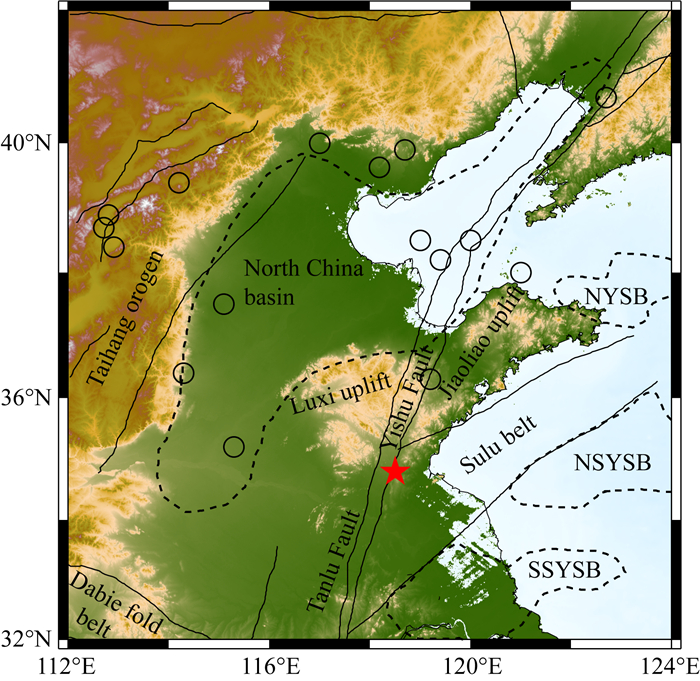
|
图 1 研究区主要区域地质构造示意图 黑色实线为主要活动断裂.Taihang orogen,太行山造山带;North China basin,华北盆地;Luxi uplift,鲁西隆起;Jiaoliao uplift,胶辽隆起;NYSB,北黄海盆地;Sulu belt,苏鲁褶皱带;NSYSB,南黄海北部盆地;SSYSB,南黄海南部盆地;Yishu Fault,沂沭断裂带;Tanlu Fault,郯庐断裂带.虚线代表块体边界, 圆圈代表 7级以上地震, 红色五角星代表1668年郯城8½级地震. Fig. 1 Sketch map of regional geological tectonics in the study region Black solid lines mark major active faults. The dashed lines represent block boundaries, whereas the circles denote epicenters of earthquakes with magnitudes greater than 7.0. The red star is the 1668 Tancheng M8½ earthquake. |

|
图 2 2008-2019年期间地震震中分布(中国地震台网中心编目系统http://10.5.160.18/console/index.action) 蓝色方框为乳山地区. Fig. 2 The epicenter distribution of the earthquakes that occurred during 2008-2019 (China Earthquake Networks Center Cataloging System http://10.5.160.18/console/index.action) The blue box represents Rushan area. |
上地幔顶部是壳幔物质交换与能量传递的关键区域(李志伟等,2011),上地幔顶部Pn波速度变化与上地幔压力、温度、物质构成有关(Hearn,1996;McNamara et al., 1997;Liang et al., 2004;He et al., 2017),而各向异性反映了地幔物质的运动及形变特征(Hearn,1996;Liang et al., 2004;Bamford,2010).因此,开展沂沭断裂带及周边区域上地幔顶部Pn波速度和各向异性结构研究,对于进一步理解该地区地震孕育的深部地球物理环境、发震机制和地球动力学过程具有重要科学意义和现实意义.
近年来,已有大量学者利用Pn波层析成像方法获得了多个中国大陆地区上地幔速度结构模型(如汪素云等, 2001, 2003;裴顺平等,2004;Hearn et al., 2004;Liang et al., 2004;Pei et al., 2007;Zhou and Lei, 2016).围绕沂沭断裂带也开展了一些相关研究,比如吕子强等(2016)和顾勤平等(2016, 2020)分别反演了环渤海地区及郯庐断裂带中南段Pn波速度结构及各向异性,殷伟伟等(2019)利用2008-2016年2级以上地震的Pn波到时资料,获得郯庐断裂带Pn波成像结果.这些研究尽管获得了有意义的研究结果,但由于资料的局限性其反演结果的分辨率相对低些.在本研究中,我们采用手工拾取研究区域2008-2019年期间2级以上地震波形的高质量Pn波到时资料,并结合2008-2019年期间观测报告中的Pn波到时资料.另外,前人工作中仅使用了山东省内的地震台站接入中国地震台网的40个台站到时资料,而本研究还增加了未接入中国地震台网的88个台站数据资料.这88个台站的加入,使得台站密集地分布在沂沭断裂带两侧,大大提高了研究区射线交叉性覆盖,对于揭示沂沐断裂带细深部特征具有重要意义.本研究所用的26598条Pn波到时数量远多于前人研究中所用到的资料数量,使得整个沂沭断裂带及周边地区Pn射线交叉性覆盖更为密集,为获取更高分辨率结构特征奠定了基础.
1 数据和方法为使沂沐断裂带能被更多的地震射线有效覆盖,本研究将资料搜集范围扩大至112°E-124°E、32°N-42°N,采用手工识别方式提取到2008-2019年期间2级以上地震事件的33397条Pn射线,并结合地震观测报告2008-2019年期间2级以上地震事件的37253条Pn射线.在合并两个数据集时,如遇重复射线时以手工拾取的到时为准.为保证数据的质量,我们采用以下标准来选取资料:(1)震中距为1.8°~12°,确保首先到达的是Pn震相;(2)震源深度小于33 km;(3)每个地震事件至少有6个台站记录到Pn震相,每个台站至少要记录到6个事件的Pn震相;(4)走时残差在±3.0 s内.按上述标准作为条件,我们最终挑选出研究区内290个台站记录到1665个地震事件的26598条Pn到时资料.图 3为Pn波射线路径分布图,可以看出整个研究区内的射线交叉覆盖较为密集.

|
图 3 研究区内290个台站(绿色钻石号)记录到1665个地震(红色圆圈)的26598条Pn波射线(蓝色细线)分布 Fig. 3 Distribution of 26598 Pn ray-paths (blue thin lines) from 1665 earthquakes (red circles) recorded at 290 seismic stations (green diamonds) |
本研究采用Hearn(1996)的成像方法,反演沂沭断裂带及周边区域上地幔顶部Pn波速度和方位各向异性结构.该方法将上地幔顶部划分成二维网格,每个网格的速度和方位各向异性是待反演项.Pn波走时残差tij可表示为

|
(1) |
式中ai和bj分别为台站i和地震事件j的静延迟,dijk为事件j到台站i经过网格k的射线长度,sk是第k个网格的慢度扰动,Ak、Bk是第k个网格的各向异性系数,φ为台站相对于事件的方位角(即反方位角).各向异性大小可表示为
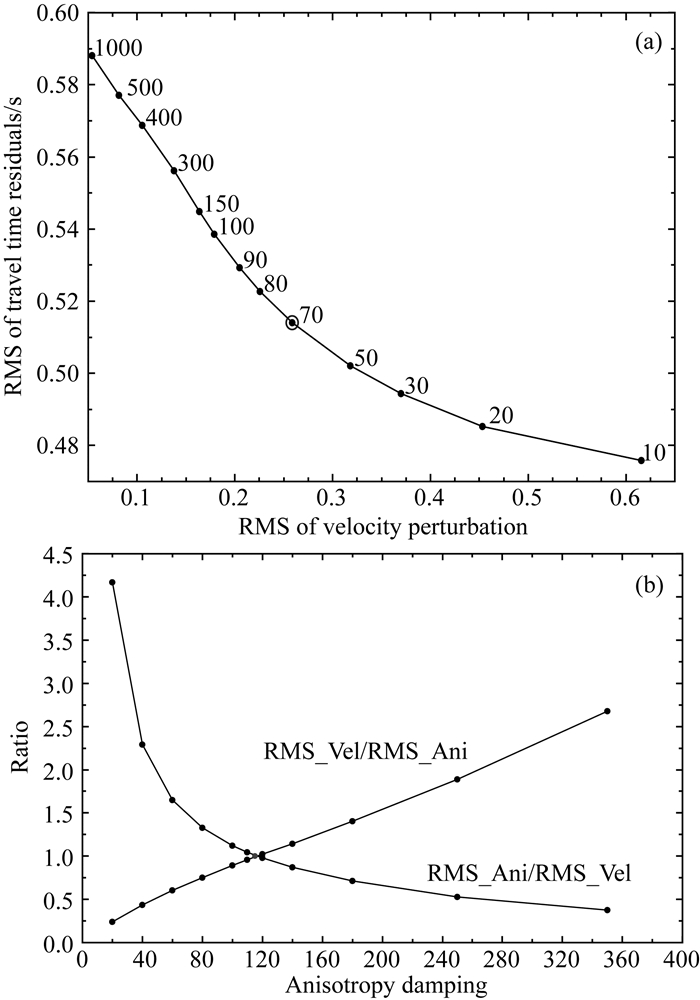
|
图 4 速度阻尼因子(a)与各向异性阻尼因子(b)的选取.有关细节请参阅正文 Fig. 4 Damping parameters chosen for velocity (a) and anisotropy (b). For details, see the text |
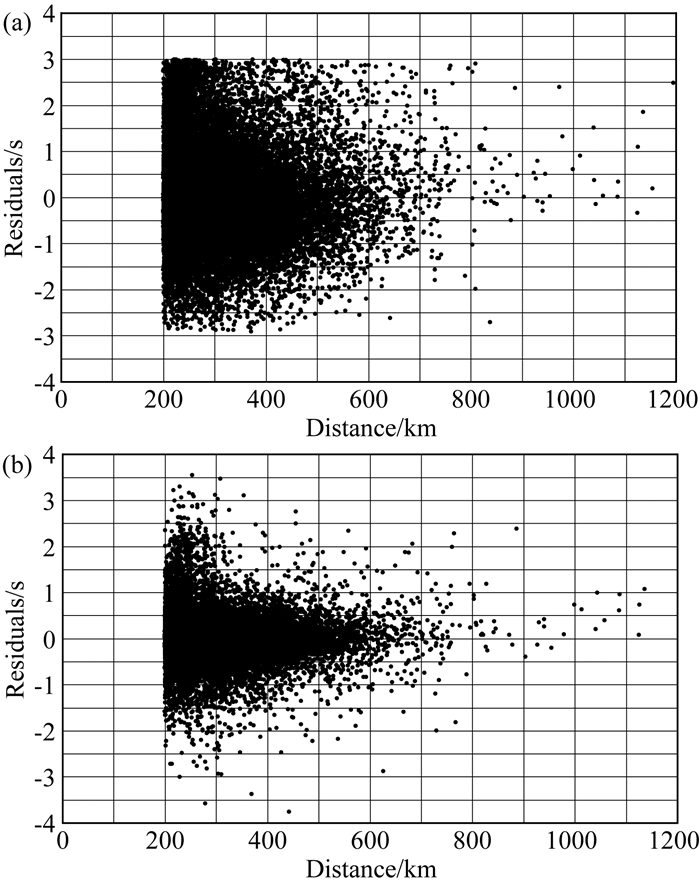
|
图 5 资料走时残差分布图 (a) 反演前;(b) 反演后. Fig. 5 Distribution of travel time residuals (a) Before the inversion; (b) After the inversion. |
为了检验反演结果的可靠程度,使用检测板实验方法对使用数据的分辨能力进行检验.初始模型Pn波速度设为7.99 km·s-1,在此基础上在每个网格单元上交替添加一定的速度大小扰动和各向异性方向扰动,采用与实际资料相同的资料数与反演方法进行反演,计算不同异常尺度的分辨率模型.图 6和图 7分别展示出研究区0.5°×0.5°的速度异常恢复结果和1.0°×1.0°各向异性异常恢复结果,可以看出绝大部分区域异常的形态和幅度均得到比较好的恢复,只有东部海域边缘地区恢复的异常存在变形,这与射线交叉性覆盖程度(图 3)相一致,表明研究区域速度异常分辨率达到0.5°×0.5°,而各向异性异常分辨率达到1.0°×1.0°,因此本文仅讨论与此分辨率相当的异常尺度的结构特征.
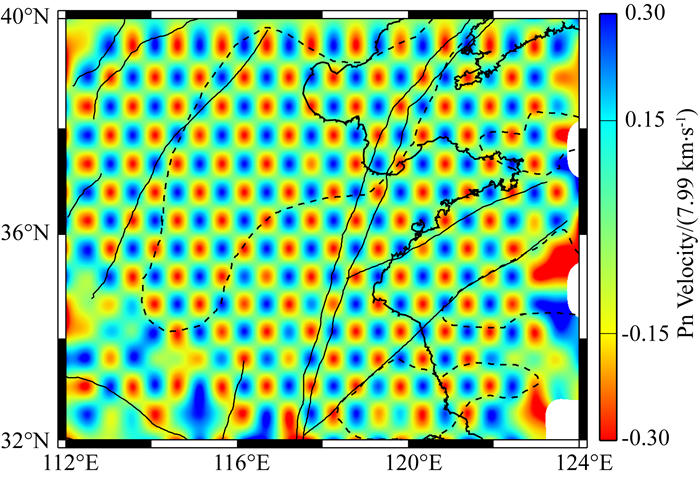
|
图 6 异常尺度为0.5°×0.5°的Pn波速度检测板分辨率实验结果 Fig. 6 Results of the checkerboard resolution test for Pn velocity with an anomaly size of 0.5°×0.5° |
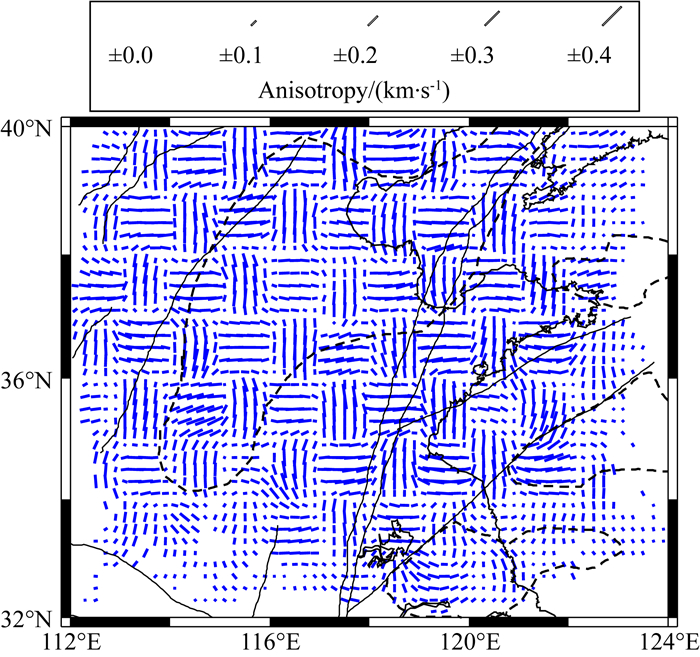
|
图 7 异常尺度为1.0°×1.0°的Pn波各向异性检测板分辨率实验结果 Fig. 7 Results of the checkerboard resolution test for Pn anisotropy with an anomaly size of 1.0°×1.0° |
图 8给出了研究区域Pn波速度结构(模型结果数据参见电子附件),其中蓝色和红色分别表示高速异常和低速异常.由图可以看出,研究区域速度结构存在明显的横向不均匀性,与区域地质构造明显相关,且异常形态与地质构造比较吻合.华北盆地显示出明显的高速异常,异常形态清晰地勾勒出华北盆地构造块体的轮廓,且盆地内部速度结构也存在显著的横向不均匀性.相对于前人的研究结果(汪素云等,2003;Huang and Zhao, 2004;李志伟等,2006;Lei et al., 2008;于湘伟等,2010;Li et al., 2011;吕子强等,2016;殷伟伟等,2019),本研究可以更清晰地展现出华北盆地一些细结构特征,比如华北盆地内部强高速异常表现出明显的分块现象,这在以往前人研究结果中从未揭示出来.华北盆地南端表现为低速异常,苏鲁褶皱带呈现低速异常但不连续,显示出两个低速异常块体并沿断裂带的走向相间排列,其两侧的速度异常也明显不同,分别表现出高速异常和低速异常,表明断裂带两侧上地幔顶部的介质强度不同,具有不同的构造环境特征.太行山造山带呈现低速异常,且异常形态沿山脉走向分布.沂沭断裂带东西两侧的速度异常差别明显,并表现出明显的分段特征,大致以鲁西隆起和郯城地震为界线,鲁西隆起以北、沂沭断裂带西侧地区表现为高速异常,其东侧表现为低速异常;郯城地震以南地区则相反,其西侧表现为低速异常,东侧则表现为高速异常.这些结构特征表明,沂沭断裂带可能深延达上地幔顶部(叶高峰等,2009;徐义刚等,2009;牛漫兰等,2000;漆家福等,2010;黄耘等,2011;Lei,2012).朱日祥等(2012)研究指出太平洋板块的俯冲是华北克拉通破坏的一级动力学因素,郯庐断裂带在克拉通破坏之前就存在,其岩石圈强度较低,有利于岩浆运移,在克拉通破坏期间,成为强烈的伸展带和岩浆带.最近的华北地区上地幔顶部研究结果(Lü et al., 2020)与本研究呈现很相似的反演结果,且也支持该推论.鲁西隆起表现为低速异常,可能源于太平洋板块西向深俯冲形成“大地幔楔”结构(Lei and Zhao, 2005, 2006; Lei et al., 2020)导致深部地幔热物质沿沂沭断裂带向上涌动形成,其伸展构造形成过程中幔源岩浆活动及热侵蚀起到重要作用(燕守勋等,1996),这种热物质上涌还得到最近地壳结构成像结果(孟亚锋等,2019;Ma et al., 2020; Tian et al., 2020)的支持.沂沭断裂带东侧的胶辽隆起表现为低速异常,与鲁西隆起的异常程度表现不同,暗示这两个隆起区上地幔顶部具有不同的介质强度.黄海海域盆地几乎全部表现为高速异常,说明盆地内部上地幔介质刚度较高,结构稳定.胶东半岛与南黄海北部为低速异常且相连,说明两区域的地幔介质性质可能相近.
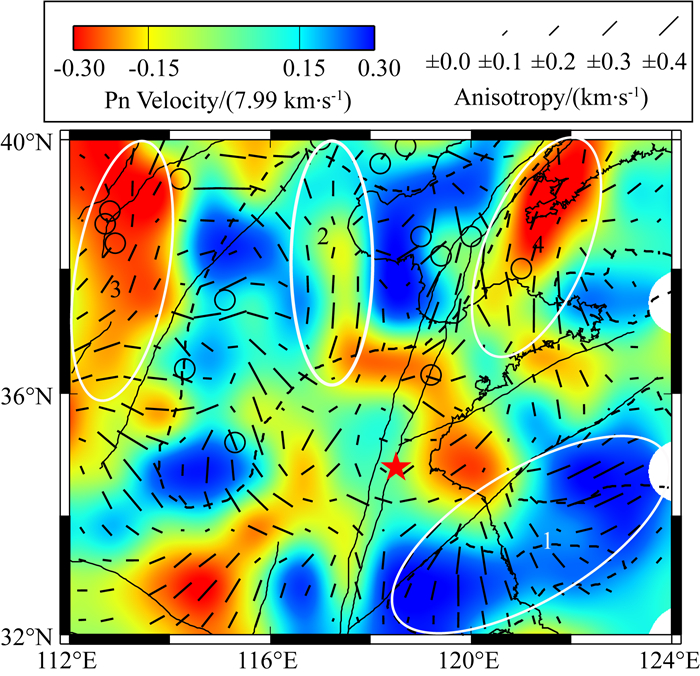
|
图 8 获得的研究区Pn波速度和各向异性结果 红色和蓝色分别表示低速和高速异常,黑色短线方向为快波方向,长度与各向异性的大小成正比,速度与各向异性色标位于图顶.四个白色椭圆分别代表了四个特定区域.其他标示与图 1中的相同. Fig. 8 Pn velocity and anisotropy inferred in the study region The red and blue colors denote low- and high-velocity anomalies. The black short lines show the fast direction of Pn propagation, the length of which is proportional to the amount of anisotropy. The scales of velocity and anisotropy are shown on the top. Four white ellipses denote four specific areas. The other labeling is the same as that in Fig. 1. |
图 8展示出研究区7级以上的地壳内强震震中分布,红色五角星代表1668年郯城8½级地震位置.由图可以看出,强震发生的区域与Pn波速度分布密切相关,多数强震发生在高速和低速异常交界区域上方的地壳内,特别是速度变化剧烈的地带.雷建设等(2009)对龙门山断裂带地壳精细结构与汶川地震发震机理研究指出,汶川地震余震主要发生在速度表现出比较强烈的横向不均匀的地区,且汶川主震震源区下方存在有显著的低波速异常体.也有学者采用地震层析成像研究揭示华北大震大多都发生在高速与低速区的过渡带上(王椿镛等,2017).魏斯禹和滕吉文(1985)对我国几个大地震地区地壳与上地幔顶部结构关系的分析指出,上地幔顶部的局部隆起地带是地壳大地震孕育和发生的深部构造背景,造成局部隆起的物理机制是由于上地幔结构和物质组成的不均匀性以及上地幔热物质的上涌,而上地幔顶部Pn波速度的变化与上地幔压力、温度、物质构成密切相关,上述这些研究结果也都印证了本文的观点,说明壳内强震的孕育发生与上地幔顶部速度结构分布有关.低速异常说明介质温度较高(汪素云等,2003),容易产生韧性形变,导致应变能积累;高低速异常交界区域意味着相应区域介质性质存在明显差别,应力在流变边界集中(Artyushkov,1973;Zhang et al., 2009),容易诱发地震.地震活动十分活跃的乳山和长岛地区就位于低速异常区域的边缘上(图 8),暗示乳山震群和长岛震群的发生可能与Pn波速度结构有关.前人研究结果表明,通常发生地震的断裂带两侧的速度异常存在较为明显差别(雷建设等,2009),沂沭断裂带和苏鲁褶皱带交汇处速度结构横向差异明显,容易导致应力集中,产生应力差,1668年郯城8½级地震震中的位置就位于此处,这可能是郯城地震发生的主要成因之一(图 8),这一认识在其他地区的研究结果中也得到证实(雷建设等,2009;黎源和雷建设,2012;Lei et al., 2014;Zhou and Lei, 2015).
2.3 Pn波各向异性Pn波各向异性通常被认为是由于上地幔顶部物质发生变形导致橄榄岩晶格优势排列引起的(Hess,1964;Christensen,1984;Nicolas and Christensen, 1987),反映最近一次构造变形的特征.总体上,在简单剪切形变情况下,各向异性的快波方向表现为与剪切带走向平行,如板块边缘和穿透地壳的剪切带以及岩石圈地幔的剪切拖曳带;在纯剪切形变情况下,快波方向与最大拉伸方向一致,如岩石圈中没有断裂活动的地区(Savage and Silver, 1993;Silver,1996;Hearn, 1996, 1999).图 8为研究区Pn波各向异性(模型结果数据参见电子附件)分布图,反映了研究区上地幔顶部的形变特征,其中短线方向表示快波传播方向,其长短表示各向异性的强弱.可以看出,Pn波各向异性与区域地质构造和速度结构具有一定的关联.尽管个别稳定地块因为保留了较早形成的“化石”各向异性,其各向异性呈现出一定程度的强各向异性,如黄海盆地(图 8中的白色大椭圆1),但多数呈现出低速异常的太行山造山带、华北盆地南部以及胶辽隆起区各向异性相对较强(图 8),这些区域上地幔介质韧性大,容易发生形变,这与青藏高原东缘地区上地幔顶部定量统计结果(Lei et al., 2014)相一致.在沂沭断裂带内部Pn波各向异性快波优势方向与该断裂带走向基本一致,说明沂沭断裂带的活动以简单剪切为主,剪切深度达上地幔顶部.华北盆地内部各向异性变化较为明显,西部与太行山造山带交界区域Pn波各向异性快波方向为近E-W向,盆地中部弱低速区各向异性快波方向为近N-S向(图 8中的白色大椭圆2).太行山造山带地区(图 8中的白色大椭圆3)和胶辽隆起区域(图 8中的白色大椭圆4)的Pn波各向异性快波优势方向为近NNE-SSW向,与断裂带的走向趋于一致,与该区域地质构造的伸展方向趋于一致,而SKS快波方向为NW-SE方向(常利军等, 2009, 2012;苗庆杰等,2011;吴萍萍等,2012),这种显著差异暗示该区域岩石圈在一定深度可能存在局部解耦现象.由于郯庐断裂大规模剪切运动使东侧南黄海扬子块体向北运动嵌入中朝块体,在南黄海地区形成若干NE-SW或NNE-SSW向伸展的隆起和坳陷,这与利用重力异常资料推测得到的黄海地区断裂体系是由N-S向和NE-SW或NNE-SSW向两组断裂构成的研究结果(郝天珧等,2002;王谦身等,2003)相一致.在南黄海北部盆地Pn波各向异性快波方向为近NE-SW向,而南黄海南部盆地Pn波各向异性快波优势方向为近N-S方向(白色椭圆1),与区域断裂走向基本平行,与构造伸展方向趋于一致,暗示南黄海地区部分断裂的深度已达上地幔顶部成为岩石圈尺度的断裂.
2.4 不同资料集成像结果对比为了解手工提取资料与观测报告中资料对成像结果的差别,本研究将手工提取的33397条Pn到时资料(图 9a)和观测报告中的37253条Pn射线(图 10a)分别开展反演研究,图 9b和图 10b展示出这两种资料集获得的速度与各向异性结果.由图中可以看出,两种资料集成像的结果较为接近,均显示出沂沭断裂带呈现明显的分段特征,其两侧的速度异常差别比较明显,华北盆地展现明显的高速异常,且盆地内部速度结构存在明显的横向不均匀性,太行山造山带、鲁西隆起以及胶辽隆起区域表现为低速异常,苏鲁褶皱带呈现不连续的低速异常,黄海海域盆地几乎全部表现为高速异常.太行山造山带地区和胶辽隆起区域的Pn波各向异性快波优势方向为近NNE-SSW向,南黄海北部盆地Pn波各向异性快波方向为近NE-SW向,南黄海南部盆地Pn波各向异性快波方向为近N-S向.然而,这两种资料的反演结果也存在着一些细节差别.譬如,在渤海海域,利用观测报告资料获得的结果显示出以西地区与断裂带内部为高波速异常、而以东地区为弱低波速异常(图 10);利用人工拾取资料获得的反演结果显示出郯庐断裂带以西为明显高波速异常、而以东地区为明显低波速异常的分界特征(图 9).这些结果说明,相对于观测报告(图 10a),利用人工拾取的Pn到时资料具有较好一致性、射线有较好的交叉性覆盖(图 9a),可获得更为有意义的研究结果.

|
图 9 手工提取Pn波射线分布(a)及相应的Pn波速度与各向异性成像结果(b) 其他标示分别与图 3和图 8中的相同. Fig. 9 Distributions of manually picked Pn ray-paths (a) and their results of velocity and anisotropy (b) The other labeling is the same as that in Figs. 3 and 8, respectively. |
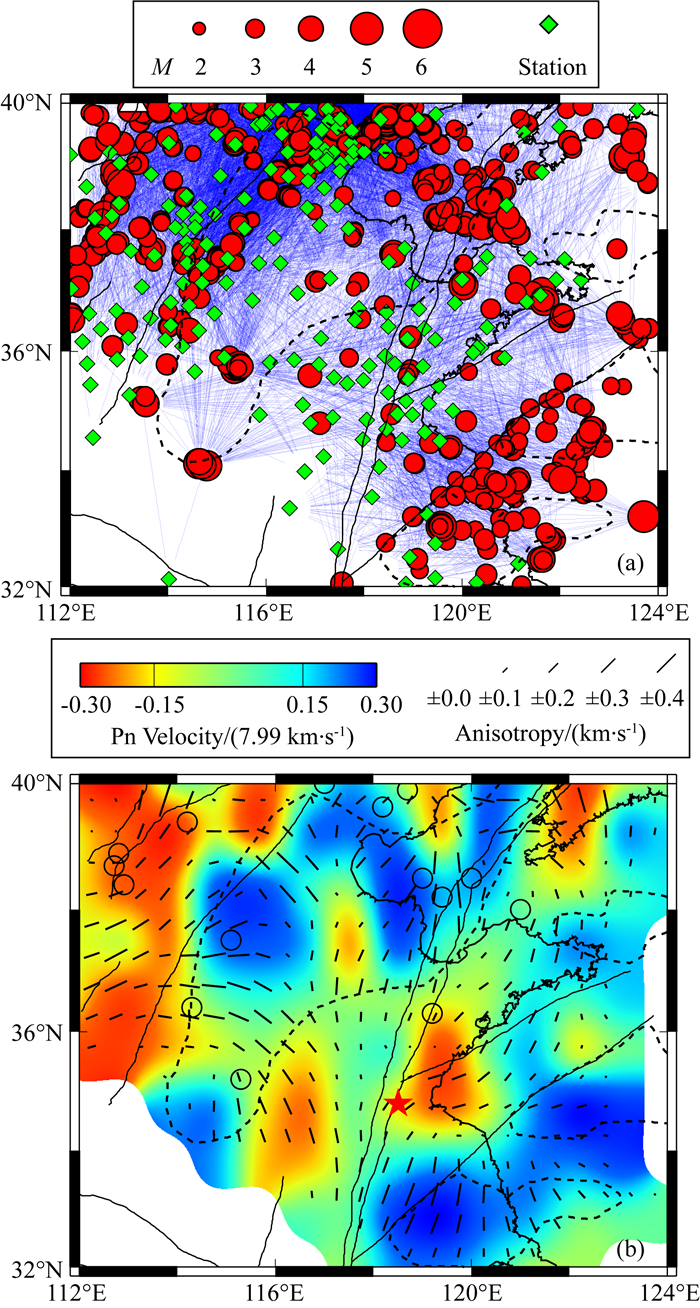
|
图 10 观测报告中的Pn波射线分布(a)及相应的速度与各向异性成像结果(b) 其他标示分别与图 3和图 8中的相同. Fig. 10 Distributions of Pn ray-paths from observational bullletins (a) and their results of velocity and anisotropy (b) The other labeling is the same as that in Figs. 3 and 8, respectively. |
通过手工拾取大量高质量的Pn波走时数据,利用Pn波层析成像方法,重建了沂沭断裂带及周边区域上地幔顶部高分辨率Pn波速度与各向异性结构模型,该模型明显地展示出与地表地质构造相关性,且揭示出前人所未揭示的结构特征,为深入理解沂沐断裂带深部结构与动力学过程提供了重要地震学依据.
(1) Pn波速度与各向异性结构和区域地质构造具有一定的关联.华北盆地显示明显的高速异常,且盆地内部强高速异常表现出明显的分块现象.苏鲁褶皱带展现两个低速异常块体并沿断裂带的走向相间排列,其两侧的速度异常也不相同,表明断裂带两侧具有不同的构造环境特征.沂沭断裂带东西两侧速度结构差别明显,且表现出明显的分段特征,大致以鲁西隆起和郯城地震为界线.构造活动强烈的太行山造山带、鲁西隆起区、胶辽隆起区的速度结构呈现低速异常,表明沂沭断裂带下方存在地幔热物质上涌.黄海海域盆地几乎全部表现为高速异常,说明其构造活动不受华北地区地幔热扰动的影响.
沂沭断裂带Pn波各向异性快波方向与断裂走向基本一致,说明沂沭断裂带的活动以简单剪切为主,且剪切深度达上地幔顶部.华北盆地内部各向异性差异较大.太行山造山带、胶辽隆起区Pn波各向异性快波方向与地质构造的伸展方向基本一致,与区域SKS快波方向存在明显差异,说明研究区内岩石圈在一定深度可能存在局部解耦现象.南黄海盆地Pn波各向异性快波方向与区域断裂的走向基本一致,暗示扬子块体向北挤压在南黄海地区形成的部分断裂的深度已达上地幔,成为岩石圈尺度的断裂带.
(2) 强震的空间分布与上地幔顶部速度分布密切相关.地壳强震主要发生在上地幔顶部的高速和低速异常的交界区域,表明壳内强震的孕育发生受到上地幔顶部构造环境影响,这可能与地幔热物质上涌、上地幔顶部介质横向不均匀性相关.郯城8½级地震位于沂沭断裂带和苏鲁褶皱带的交汇处,该区域速度结构横向差异大,是构造应力易于集中增强的地区,说明郯城地震的发生明显地受到了深部构造控制作用.
致谢 感谢Thomas M.Hearn提供的Pn波成像程序.张广伟博士和米琦博士在程序使用方面提供了帮助,河北、辽宁、北京、天津、江苏、安徽、河南、山西等区域台网为本研究提供了地震事件波形资料,两位审稿专家对本文提出了许多建设性建议,在此一并感谢!
Artyushkov E V. 1973. Stresses in the lithosphere caused by crustal thickness inhomogeneities. Journal of Geophysical Research, 78(32): 7675-7708. DOI:10.1029/JB078i032p07675 |
Bamford D. 2010. Pn velocity anisotropy in a continental upper mantle. Geophysical Journal International, 49(1): 29-48. |
Chang L J, Wang C Y, Ding Z F. 2009. Seismic anisotropy of upper mantle in eastern China. Science in China Series D: Earth Sciences, 52(6): 774-783. DOI:10.1007/s11430-009-0073-4 |
Chang L J, Wang C Y, Ding Z F. 2012. Upper mantle anisotropy beneath North China. Chinese Journal of Geophysics (in Chinese), 55(3): 886-896. DOI:10.6038/j.issn.0001-5733.2012.03.018 |
Chao H T, Li J L, Zhao Q Y, et al. 1998. Active folds in the Yishu fault zone and their relations to active faults. Journal of Seismological Research (in Chinese), 21(3): 261-267. |
Chen G X, Gao W M. 1988. The relationship between recent activity characteristics of Yishu fault zone and strong earthquake structure. Earthquake Research in China (in Chinese), 4(3): 130-135. |
Chen H S, Zhou X Q, Li D Q, et al. 1993. Geoscience Transect of Lingbi-Fengxian (HQ-13) (in Chinese). Beijing: Geological Publishing House.
|
Chen L, Zheng T Y, Xu W W. 2006. A thinned lithospheric image of the Tanlu Fault zone, eastern China: Constructed from wave equation based receiver function migration. Journal of Geophysical Research: Solid Earth, 111(B9): B09312. DOI:10.1029/2005JB003974 |
Christensen N I. 1984. The magnitude, symmetry and origin of upper mantle anisotropy based on fabric analyses of ultramafic tectonites. Geophysical Journal International, 76(1): 89-111. DOI:10.1111/j.1365-246X.1984.tb05025.x |
Fang Z J, Ding M L, Xiang H F, et al. 1986. Basic characteristics of the Tancheng-Lujiang fault zone. Chinese Science Bulletin (in Chinese), 31(20): 1406-1411. |
Gao W M, Li J L, Sun Z Y. 1980. Formation and evolution of the Yihe-Suhe continental rift. Seismology and Geology (in Chinese), 2(3): 11-18. |
Gao W M, Zheng L S, Li J L, et al. 1988. Seismogenic structure of the 1668 Tancheng M8.5 earthquake. Earthquake Research in China (in Chinese), 4(3): 9-15. |
Gu Q P, Ding Z F, Kang Q Q, et al. 2016. Pn wave velocity and anisotropy in the middle-southern segment of the Tan-Lu fault zone and adjacent region. Chinese Journal of Geophysics (in Chinese), 59(2): 504-515. DOI:10.6038/cjg20160210 |
Gu Q P, Kang Q Q, Ding Z F, et al. 2020. Uppermost mantle Pn-wave velocity and anisotropy structure beneath the Shandong-Jiangsu-Anhui segment of the Tan-Lu fault zone and its adjacent regions. Chinese Journal of Geophysics (in Chinese), 63(7): 2548-2565. DOI:10.6038/cjg2020N0403 |
Hao T Y, Suh M, Wang Q S, et al. 2002. A study on the extension of fault zones in Yellow Sea and its adjacent areas based on gravity data. Chinese Journal of Geophysics (in Chinese), 45(3): 385-397. |
He J, Sandvol E, Wu Q J, et al. 2017. Attenuation of regional seismic phases (Lg and Sn) in Eastern Mongolia. Geophysical Journal International, 211(2): 979-989. DOI:10.1093/gji/ggx349 |
Hearn T M. 1996. Anisotropic Pn tomography in the western United States. Journal of Geophysical Research: Solid Earth, 101(B4): 8403-8414. DOI:10.1029/96JB00114 |
Hearn T M. 1999. Uppermost mantle velocities and anisotropy beneath Europe. Journal of Geophysical Research: Solid Earth, 104(B7): 15123-15139. DOI:10.1029/1998JB900088 |
Hearn T M, Wang S Y, Ni J F, et al. 2004. Uppermost mantle velocities beneath China and surrounding regions. Journal of Geophysical Research: Solid Earth, 109(B11): B11301. DOI:10.1029/2003JB002874 |
Hess H H. 1964. Seismic anisotropy of the uppermost mantle under oceans. Nature, 203(4945): 629-631. DOI:10.1038/203629a0 |
Huang J L, Zhao D P. 2004. Crustal heterogeneity and seismotectonics of the region around Beijing, China. Tectonophysics, 385(1-4): 159-180. DOI:10.1016/j.tecto.2004.04.024 |
Huang R, Xu Y X, Zhu L P, et al. 2015. Detailed Moho geometry beneath southeastern China and its implications on thinning of continental crust. Journal of Asian Earth Sciences, 112: 42-48. DOI:10.1016/j.jseaes.2015.09.002 |
Huang Y, Li Q H, Zhang Y S, et al. 2011. Crustal velocity structure beneath the Shandong-Jiangsu-Anhui segment of the Tancheng-Lujiang Fault Zone and adjacent areas. Chinese Journal of Geophysics (in Chinese), 54(10): 2549-2559. DOI:10.3969/j.issn.0001-5733.2011.10.012 |
Laske G, Masters G, Ma Z, et al. 2013. Update on CRUST1.0-A 1-degree global model of Earth′s crust. Geophysical Research Abstracts, 15: 2658-2658. |
Lü Y, Xu Y H, Liu J Q, et al. 2020. Complex deformation of Central and North China through Pn velocity and anisotropy tomography. Geochemistry Geophysics Geosystems, 21(1): e2019GC008661. DOI:10.1029/2019GC008661 |
Lü Z Q, Lei J S, Zhou Z G, et al. 2016. Pn-wave velocity and anisotropy around the Bohai Sea areas. Chinese Journal of Geophysics (in Chinese), 59(6): 2047-2055. DOI:10.6038/cjg20160611 |
Lei J S, Zhao D P. 2005. P-wave tomography and origin of the Changbai intraplate volcano in Northeast Asia. Tectonophysics, 397(3-4): 281-295. DOI:10.1016/j.tecto.2004.12.009 |
Lei J S, Zhao D P. 2006. Global P-wave tomography: on the effect of various mantle and core phases. Physics of the Earth and Planetary Interiors, 154(1): 44-69. DOI:10.1016/j.pepi.2005.09.001 |
Lei J S, Xie F R, Lan C X, et al. 2008. Seismic images under the Beijing region inferred from P and PmP data. Physics of the Earth and Planetary Interiors, 168(3-4): 134-146. DOI:10.1016/j.pepi.2008.06.005 |
Lei J S, Zhao D P, Su J R, et al. 2009. Fine seismic structure under the Longmenshan fault zone and the mechanism of the large Wenchuan earthquake. Chinese Journal of Geophysics (in Chinese), 52(2): 339-345. |
Lei J S. 2012. Upper-mantle tomography and dynamics beneath the North China Craton. Journal of Geophysical Research: Solid Earth, 117(B6): B06313. DOI:10.1029/2012JB009212 |
Lei J S, Li Y, Xie F R, et al. 2014. Pn anisotropic tomography and dynamics under eastern Tibetan plateau. Journal of Geophysical Research: Solid Earth, 119(3): 2174-2198. DOI:10.1002/2013JB010847 |
Lei J S, Zhao D P, Xu X W, et al. 2020. P-wave upper-mantle tomography of the Tanlu fault zone in eastern China. Physics of the Earth and Planetary Interiors, 299: 106402. DOI:10.1016/j.pepi.2019.106402 |
Li H K, Yang Y B, Yang F J. 2009. Tectonic Evolution and Mineralization of the Yishu Fault Zone, Shandong (in Chinese). Beijing: Geological Publishing House.
|
Li H K, Zhuo C Y, Geng K, et al. 2017. Intra-continental extensional tectonics of the Tan-Lu fault zone: an example from the appearance characteristics of the Yishu fault zone. Earth Science Frontiers (in Chinese), 24(2): 73-84. |
Li J L, Chao H T, Cui Z W, et al. 1994. Segmentation of active fault along the Tancheng-Lujiang fault zone and evaluation of strong earthquake risk. Seismology and Geology (in Chinese), 16(2): 121-126. |
Li Y, Lei J S. 2012. Velocity and anisotropy structure of the uppermost mantle under the eastern Tibetan plateau inferred from Pn tomography. Chinese Journal of Geophysics (in Chinese), 55(11): 3615-3624. DOI:10.6038/j.issn.0001-5733.2012.11.010 |
Li Y H, Gao M T, Wu Q J. 2014. Crustal thickness map of the Chinese mainland from teleseismic receiver functions. Tectonophysics, 611: 51-60. DOI:10.1016/j.tecto.2013.11.019 |
Li Z W, Xu Y, Hao T Y, et al. 2006. Seismic tomography and velocity structure in the crust and upper mantle around Bohai Sea area. Chinese Journal of Geophysics (in Chinese), 49(3): 797-804. |
Li Z W, Hao T Y, Xu Y. 2011. Uppermost mantle structure of the North China Craton: constraints from interstation Pn travel time difference tomography. Chinese Science Bulletin, 56(16): 1691-1699. DOI:10.1007/s11434-011-4487-y |
Liang C, Song X D, Huang J L. 2004. Tomographic inversion of Pn travel times in China. Journal of Geophysical Research: Solid Earth, 109(B11): B11304. DOI:10.1029/2003JB002789 |
Liu B J, Feng S Y, Ji J F, et al. 2015. Fine lithosphere structure beneath the middle-southern segment of the Tan-Lu fault zone. Chinese Journal of Geophysics (in Chinese), 58(5): 1610-1621. DOI:10.6038/cjg20150513 |
Liu C Q, Zhu Z P, Li H D, et al. 1983. Lianyungang-Linyi-Sishui sounding profile and the deep structural background of the Linyi M8.5 earthquake. Earthquake (in Chinese), (3): 11-17. |
Lu Z X, Xia H K. 1992. Geoscience Transection from Eastern Ujimqin Banner in Inner Mongolia to Donggou in Liaoning (in Chinese). Beijing: Seismological Press.
|
Ma C, Lei J S, Xu X W. 2020. Three-dimensional shear-wave velocity structure under the Weifang segment of the Tanlu fault zone in eastern China inferred from ambient noise tomography with a short-period dense seismic array. Physics of the Earth and Planetary Interiors, 309: 106590. DOI:10.1016/j.pepi.2020.106590 |
Ma X Y, Liu C Q, Liu G D. 1991. Xiangshui (Jiangsu Province) to Mandal (Nei Monggol) Geoscience transect. Acta Geologica Sinica (in Chinese), (3): 199-215. |
McNamara D E, Walter W R, Owens T J, et al. 1997. Upper mantle velocity structure beneath the Tibetan Plateau from Pn travel time tomography. Journal of Geophysical Research: Solid Earth, 102(B1): 493-505. DOI:10.1029/96JB02112 |
Meng Y F, Yao H J, Wang X Z, et al. 2019. Crustal velocity structure and deformation features in the central-southern segment of Tanlu fault zone and its adjacent area from ambient noise tomography. Chinese Journal of Geophysics (in Chinese), 62(7): 2490-2509. DOI:10.6038/cjg2019M0189 |
Miao Q J, Liu X Q, Li Y H. 2011. Study on seismic anisotropy of upper mantle beneath Shandong region. Acta Seismologica Sinica (in Chinese), 33(6): 746-754. |
Nicolas A, Christensen N I. 1987. Formation of anisotropy in upper mantle peridotites-A review. //Fuchs K, Froidevaux C eds. Composition, Structure and Dynamics of the Lithosphere-Asthenosphere System. Washington, D.C. : Geodynamics Series, 16: 111-123.
|
Niu M L, Zhu G, Song C Z, et al. 2000. Volcanic activities and deep geological processes in the Tan-Lu fault zone. Geological Science and Technology Information (in Chinese), 19(3): 21-26. |
Niu M L, Zhu G, Liu G S, et al. 2005. Cenozoic volcanic activities and deep processes in the middle-south sector of the Tan-Lu fault zone. Chinese Journal of Geology (in Chinese), 40(3): 390-403. |
Pei S P, Xu Z H, Wang S Y. 2004. Discussion on origin of Pn velocity variation in China and adjacent region. Acta Seismologica Sinica (in Chinese), 26(1): 1-10. DOI:10.1007/BF03191389 |
Pei S P, Zhao J M, Sun Y S, et al. 2007. Upper mantle seismic velocities and anisotropy in China determined through Pn and Sn tomography. Journal of Geophysical Research: Solid Earth, 112(B5): B05312. DOI:10.1029/2006JB004409 |
Qi J F, Zhou X H, Wang Q S. 2010. Structural model and Cenozoic kinematics of Tan-Lu deep fracture zone in Bohai Sea area. Geology in China (in Chinese), 37(5): 1231-1242. |
Savage M K, Silver P G. 1993. Mantle deformation and tectonics: constraints from seismic anisotropy in the western United States. Physics of the Earth and Planetary Interiors, 78(3-4): 207-227. DOI:10.1016/0031-9201(93)90156-4 |
Silver P G. 1996. Seismic anisotropy beneath the continents: probing the depths of geology. Annual Review of Earth and Planetary Sciences, 24: 385-432. DOI:10.1146/annurev.earth.24.1.385 |
Tian F F, Lei J S, Xu X W. 2020. Teleseismic P-wave crustal tomography of the Weifang segment on the Tanlu fault zone: a case study based on short-period dense seismic array experiment. Physics of the Earth and Planetary Interiors, 306: 106521. DOI:10.1016/j.pepi.2020.106521 |
Wan T F, Zhu H, Zhao L, et al. 1996. Formation and evolution of Tancheng-Lujiang fault zone: a review. Geoscience (in Chinese), 10(2): 159-168. |
Wang C Y, Wu Q J, Duan Y H, et al. 2017. Crustal and upper mantle structure and deep tectonic genesis of large earthquakes in North China. Science China Earth Sciences, 60(5): 821-857. DOI:10.1007/s11430-016-9009-1 |
Wang Q S, Liu J H, Hao T Y, et al. 2003. Deep tectonics between South Yellow Sea and North East China Sea. Progress in Geophysics (in Chinese), 18(2): 276-282. |
Wang S Y, Hearn T M, Xu Z H, et al. 2001. Velocity structure of uppermost mantle beneath China continent from Pn tomography. Science in China Series D: Earth Sciences, 45(2): 143-150. |
Wang S Y, Xu Z H, Pei S P. 2003. Pn velocity variation beneath China mainland and deep structure background for major earthquake generation. Chinese Journal of Geology (in Chinese), 46(6): 779-785. |
Wang X F, Li Z J, Chen B L, et al. 2000. On Tan-Lu Fault Zone (in Chinese). Beijing: Geological Publishing House.
|
Wang Z C, Jia R G, Sun Z M, et al. 2005. Geometry and activity of the Anqiu-Zhuli segment of the Anqiu-Juxian fault in the Yishu fault zone. Seismology and Geology (in Chinese), 27(2): 212-220. |
Wei S Y, Teng J W. 1985. The preliminary study of the relation between crust and top structure of upper mantle in several large earthquake areas in China. Northwestern Seismological Journal (in Chinese), 7(2): 77-84. |
Wu P P, Wang C Y, Ding Z F, et al. 2012. Seismic anisotropy of upper mantle beneath the Dabie-Sulu and its adjacent areas. Chinese Journal of Geology (in Chinese), 55(8): 2539-2550. DOI:10.6038/j.issn.0001-5733.2012.08.006 |
Xu Y G, Li H Y, Pang C J, et al. 2009. On the timing and duration of the destruction of the North China Craton. Chinese Science Bulletin, 54(19): 3379-3396. |
Yan L J, Zhu G, Lin S Z, et al. 2014. Neotectonic activity and formation mechanism of the Yishu fault Zone. Science China: Earth Sciences, 57(4): 614-629. DOI:10.1007/s11430-013-4725-z |
Yan S X, Wang G L, Shao Z J. 1996. Extensional tectonic model of crustal elevation in western Shandong. Acta Geologica Sinica (in Chinese), 70(1): 1-11. |
Ye G F, Wei W B, Jin S, et al. 2009. Study of the electrical structure and its geological meanings of the middle part of Tancheng-Lujiang fault zone. Chinese Journal of Geology (in Chinese), 52(11): 2818-2825. DOI:10.3969/j.issn.0001-5733.2009.11.016 |
Yin A, Nie S Y. 1993. An indentation model for the North and South China collision and the development of the Tan-Lu and Honam Fault systems, Eastern Asia. Tectonics, 12(4): 801-813. DOI:10.1029/93TC00313 |
Yin W W, Lei J S, Du M F, et al. 2019. Uppermost-mantle Pn velocity and anisotropic tomography of the Tanlu fault zone and adjacent areas. Chinese Journal of Geology (in Chinese), 62(11): 4227-4238. DOI:10.6038/cjg2019M0672 |
Yu X W, Chen Y T, Zhang H. 2010. Three-dimensional crustal P-wave velocity structure and seismicity analysis in Beijing-Tianjin-Tangshan Region. Chinese Journal of Geophysics (in Chinese), 53(8): 1817-1828. DOI:10.3969/j.issn.0001-5733.2010.08.007 |
Zhang G M, Ma H S, Wang H, et al. 2004. The relationship between active blocks and strong earthquakes in Mainland China. Science in China Series D: Earth Sciences (in Chinese), 34(7): 591-599. |
Zhang P, Wang L S, Shi H S, et al. 2010. The Mesozoic-Cenozoic tectonic evolution of the Shandong segment of the Tan-Lu fault zone. Acta Geologica Sinica (in Chinese), 84(9): 1316-1323. |
Zhang P, Li L M, Ran Y K, et al. 2015. Research on characteristics of Late Quaternary activity of the Jiangsu segment of Anqiu-Juxian fault in the Tanlu fault zone. Seismology and Geology (in Chinese), 37(4): 1162-1176. |
Zhang P Z, Deng Q D, Zhang G M, et al. 2003. Active tectonic blocks and strong earthquakes in the continent of China. Science in China Series D: Earth Sciences, 46(S1): 13-24. |
Zhang Q, Sandvol E, Liu M. 2009. Lithospheric velocity structure of the New Madrid Seismic Zone: A joint teleseismic and local P tomographic study. Geophysical Research Letters, 36(11): L11305. DOI:10.1029/2009GL037687 |
Zhou Z G, Lei J S. 2015. Pn anisotropic tomography under the entire Tienshan orogenic belt. Journal of Asian Earth Sciences, 111: 568-579. DOI:10.1016/j.jseaes.2015.06.009 |
Zhou Z G, Lei J S. 2016. Pn anisotropic tomography and mantle dynamics beneath China. Physics of the Earth and Planetary Interiors, 257: 193-204. DOI:10.1016/j.pepi.2016.06.005 |
Zhu G, Niu M L, Liu G S, et al. 2002. Structural, magmatic and sedimentary events of the Tan-Lu fault belt during its early cretaceous strike-slip movement. Acta Geologica Sinica (in Chinese), 76(3): 325-334. |
Zhu R X, Xu Y G, Zhu G, et al. 2012. Destruction of the North China Craton. Science China Earth Sciences, 55(10): 1565-1587. DOI:10.1007/s11430-012-4516-y |
常利军, 王椿镛, 丁志峰. 2009. 中国东部上地幔各向异性研究. 中国科学D辑: 地球科学, 39(9): 1169-1178. |
常利军, 王椿镛, 丁志峰. 2012. 华北上地幔各向异性研究. 地球物理学报, 55(3): 886-896. DOI:10.6038/j.issn.0001-5733.2012.03.018 |
晁洪太, 李家灵, 赵清玉, 等. 1998. 沂沭断裂带活动褶皱及其与活动断层的关系. 地震研究, 21(3): 261-267. |
陈国星, 高维明. 1988. 沂沭断裂带现代活动特征及其与强震构造的关系. 中国地震, 4(3): 130-135. |
陈沪生, 周雪清, 李道琪, 等. 1993. 中国东部灵璧-奉贤(HQ-13)地学断面图. 北京: 地质出版社.
|
方仲景, 丁梦林, 向宏发, 等. 1986. 郯庐断裂带基本特征. 科学通报, 31(1): 52-55. |
高维明, 李家灵, 孙竹友. 1980. 沂沭大陆裂谷的生成与演化. 地震地质, 2(3): 11-18. |
高维明, 郑朗荪, 李家灵, 等. 1988. 1668年郯城8.5级地震的发震构造. 中国地震, 4(3): 9-15. |
顾勤平, 丁志峰, 康清清, 等. 2016. 郯庐断裂带中南段及邻区Pn波速度结构与各向异性. 地球物理学报, 59(2): 504-515. DOI:10.6038/cjg20160210 |
顾勤平, 康清清, 丁志峰, 等. 2020. 郯庐断裂带鲁苏皖段及邻区上地幔顶部Pn波速度与各向异性. 地球物理学报, 63(7): 2548-2565. DOI:10.6038/cjg2020N0403 |
郝天珧, Suh M, 王谦身, 等. 2002. 根据重力数据研究黄海周边断裂带在海区的延伸. 地球物理学报, 45(3): 385-397. DOI:10.3321/j.issn:0001-5733.2002.03.010 |
黄耘, 李清河, 张元生, 等. 2011. 郯庐断裂带鲁苏皖段及邻区地壳速度结构. 地球物理学报, 54(10): 2549-2559. DOI:10.3969/j.issn.0001-5733.2011.10.012 |
雷建设, 赵大鹏, 苏金蓉, 等. 2009. 龙门山断裂带地壳精细结构与汶川地震发震机理. 地球物理学报, 52(2): 339-345. |
李洪奎, 杨永波, 杨锋杰. 2009. 山东沂沭断裂带构造演化与成矿作用. 北京: 地质出版社.
|
李洪奎, 禚传源, 耿科, 等. 2017. 郯-庐断裂带陆内伸展构造: 以沂沭断裂带的表现特征为例. 地学前缘, 24(2): 73-84. |
李家灵, 晁洪太, 崔昭文, 等. 1994. 郯庐活断层的分段及其大震危险性分析. 地震地质, 16(2): 121-126. |
黎源, 雷建设. 2012. 青藏高原东缘上地幔顶部Pn波速度结构及各向异性研究. 地球物理学报, 55(11): 3615-3624. DOI:10.6038/j.issn.0001-5733.2012.11.010 |
李志伟, 胥颐, 郝天珧, 等. 2006. 环渤海地区的地震层析成像与地壳上地幔结构. 地球物理学报, 49(3): 797-804. DOI:10.3321/j.issn:0001-5733.2006.03.023 |
李志伟, 郝天珧, 徐亚. 2011. 华北克拉通上地幔顶部构造特征: 来自台站间Pn波到时差成像的约束. 科学通报, 56(12): 962-970. |
刘保金, 酆少英, 姬计法, 等. 2015. 郯庐断裂带中南段的岩石圈精细结构. 地球物理学报, 58(5): 1610-1621. DOI:10.6038/cjg20150513 |
刘昌铨, 祝治平, 李捍东, 等. 1983. 连云港-临沂-泗水测深剖面及临沂8.5级地震深部构造背景. 地震, (3): 11-17. |
卢造勋, 夏怀宽. 1992. 内蒙古东乌珠穆沁旗至辽宁东沟地学断面. 北京: 地震出版社.
|
吕子强, 雷建设, 周智刚, 等. 2016. 环渤海地区Pn波速度结构与各向异性. 地球物理学报, 59(6): 2047-2055. DOI:10.6038/cjg20160611 |
马杏垣, 刘昌铨, 刘国栋. 1991. 江苏响水至内蒙古满都拉地学断面. 地质学报, (3): 199-215. |
孟亚锋, 姚华建, 王行舟, 等. 2019. 基于背景噪声成像方法研究郯庐断裂带中南段及邻区地壳速度结构与变形特征. 地球物理学报, 62(7): 2490-2509. DOI:10.6038/cjg2019M0189 |
苗庆杰, 刘希强, 李永华, 等. 2011. 山东地区上地幔各向异性研究. 地震学报, 33(6): 746-754. DOI:10.3969/j.issn.0253-3782.2011.06.005 |
牛漫兰, 朱光, 宋传中, 等. 2000. 郯庐断裂带火山活动与深部地质过程的新认识. 地质科技情报, 19(3): 21-26. DOI:10.3969/j.issn.1000-7849.2000.03.005 |
牛漫兰, 朱光, 刘国生, 等. 2005. 郯庐断裂带中-南段新生代火山活动与深部过程. 地质科学, 40(3): 390-403. DOI:10.3321/j.issn:0563-5020.2005.03.008 |
裴顺平, 许忠淮, 汪素云. 2004. 中国及邻区Pn波速度结构成因探讨. 地震学报, 26(1): 1-10. DOI:10.3321/j.issn:0253-3782.2004.01.001 |
漆家福, 周心怀, 王谦身. 2010. 渤海海域中郯庐深断裂带的结构模型及新生代运动学. 中国地质, 37(5): 1231-1242. DOI:10.3969/j.issn.1000-3657.2010.05.001 |
万天丰, 朱鸿, 赵磊, 等. 1996. 郯庐断裂带的形成与演化: 综述. 现代地质, 10(2): 159-168. |
王椿镛, 吴庆举, 段永红, 等. 2017. 华北地壳上地幔结构及其大地震深部构造成因. 中国科学: 地球科学, 47(6): 684-719. |
王谦身, 刘建华, 郝天珧, 等. 2003. 南黄海南部与东海北部之间的深部构造. 地球物理学进展, 18(2): 276-282. DOI:10.3969/j.issn.1004-2903.2003.02.015 |
汪素云, Hearn T M, 许忠淮, 等. 2001. 中国大陆上地幔顶部Pn速度结构. 中国科学(D辑), 31(6): 449-454. |
汪素云, 许忠淮, 裴顺平. 2003. 中国大陆Pn波速度结构与强震孕育的深部背景. 地球物理学报, 46(6): 779-785. DOI:10.3321/j.issn:0001-5733.2003.06.009 |
王小凤, 李中坚, 陈柏林, 等. 2000. 郯庐断裂带. 北京: 地质出版社.
|
王志才, 贾荣光, 孙昭民, 等. 2005. 沂沭断裂带安丘-莒县断裂安丘-朱里段几何结构与活动特征. 地震地质, 27(2): 212-220. DOI:10.3969/j.issn.0253-4967.2005.02.004 |
魏斯禹, 滕吉文. 1985. 我国几个大地震地区地壳与上地幔顶部结构关系的初步分析. 西北地震学报, 7(2): 77-84. |
吴萍萍, 王椿镛, 丁志峰, 等. 2012. 大别-苏鲁及邻区上地幔的各向异性. 地球物理学报, 55(8): 2539-2550. DOI:10.6038/j.issn.0001-5733.2012.08.006 |
徐义刚, 李洪颜, 庞崇进, 等. 2009. 论华北克拉通破坏的时限. 科学通报, 54(14): 1974-1989. |
严乐佳, 朱光, 林少泽, 等. 2014. 沂沭断裂带新构造活动规律与机制. 中国科学: 地球科学, 44(7): 1452-1467. |
燕守勋, 王桂梁, 邵震杰. 1996. 鲁西地壳隆升的伸展构造模式. 地质学报, 70(1): 1-11. |
叶高峰, 魏文博, 金胜, 等. 2009. 郯庐断裂带中段电性结构及其地学意义研究. 地球物理学报, 52(11): 2818-2825. DOI:10.3969/j.issn.0001-5733.2009.11.016 |
殷伟伟, 雷建设, 杜沫霏, 等. 2019. 郯庐断裂带及其邻区上地幔顶部Pn波速度与各向异性层析成像. 地球物理学报, 62(11): 4227-4238. DOI:10.6038/cjg2019M0672 |
于湘伟, 陈运泰, 张怀. 2010. 京津唐地区地壳三维P波速度结构与地震活动性分析. 地球物理学报, 53(8): 1817-1828. DOI:10.3969/j.issn.0001-5733.2010.08.007 |
张国民, 马宏生, 王辉, 等. 2004. 中国大陆活动地块与强震活动关系. 中国科学D辑: 地球科学, 34(7): 591-599. |
张鹏, 王良书, 石火生, 等. 2010. 郯庐断裂带山东段的中新生代构造演化特征. 地质学报, 84(9): 1316-1323. |
张鹏, 李丽梅, 冉勇康, 等. 2015. 郯庐断裂带安丘-莒县断裂江苏段晚第四纪活动特征研究. 地震地质, 37(4): 1162-1176. DOI:10.3969/j.issn.0253-4967.2015.04.018 |
张培震, 邓起东, 张国民, 等. 2003. 中国大陆的强震活动与活动地块. 中国科学(D辑), 33(S1): 12-20. |
朱光, 牛漫兰, 刘国生, 等. 2002. 郯庐断裂带早白垩世走滑运动中的构造、岩浆、沉积事件. 地质学报, 76(3): 325-334. DOI:10.3321/j.issn:0001-5717.2002.03.005 |
朱日祥, 徐义刚, 朱光, 等. 2012. 华北克拉通破坏. 中国科学: 地球科学, 42(8): 1135-1159. |
 2021, Vol. 64
2021, Vol. 64


